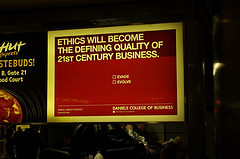|
|
|
Wednesday, February 24th, 2016

Have you read yet the story of Talia Jane?
She is a customer service rep at Yelp, whose pay puts her right down there with Walmart and bank tellers.
“I got paid yesterday ($733.24, bi-weekly) but I have to save as much of that as possible to pay my rent ($1245) for my apartment that’s 40 miles away from work because it was the cheapest place I could find that had access to the train, which costs me $5.65 one way to get to work. That’s $11.30 a day, by the way. I make $8.15 an hour after taxes.” (Minimum wage in San Francisco is $12.25 an hour.)
She was fired two hours after writing an open letter to Yelp CEO Jeremy Stoppelman on Medium.
Yelp, of course, says the letter had nothing to do with her termination.
Stoppleman has a solution.
“The reality of such a high Bay Area cost of living is entry level jobs migrate to where costs of living are lower. Have already announced we are growing EAT24 support in AZ for this reason.”
Stoppleman’s solution seems to be to kick out everyone who doesn’t earn a fat salary — how dare “them” have the temerity to want to enjoy the pleasures and opportunities of life in San Francisco/Silicon Valley.
That said, I’ve never understood why Walmart, banks, Yelp or all those who follow in their footsteps, pay their front-line people—the actual “face of the company”— what can amount to starvation wages in urban areas and then are surprised when those same people lie, cheat, steal or speak out publicly.
Tony Hsieh, of Zappos fame, Costco and Trader Joe’s are a different story.
What it comes down to is that the further away from contact with customers the greater the money, perks and benefits.
Crazy.
Flickr image credit: Javier Morales
Posted in Compensation, Culture, Leadership, Retention | No Comments »
Tuesday, February 16th, 2016

The way you treat your employees affects more than your retention rate.
It can have a major impact on your company’s trainsecurity.
Banks are an excellent example. They are notorious for the low pay, haphazard training and opportunities and iffy managers that frontline employees, i.e., tellers, endure.
But it is the pay that is especially erroneous.
According to the Bureau of Labor Statistics, the median annual income for tellers in 2014 was $25,760, a salary that prosecutors say does not match the high-risk nature of their jobs.
Raising a family and paying bills on $25K a year is beyond difficult, which increases temptation, yet these are the people who have the most access and opportunity to rip off customers.
And many of them are doing just that.
Rich and elderly bank customers are particularly at risk, prosecutors say, when tellers and other retail-branch employees tap into accounts to wire funds without authorization, make fake debit cards to withdraw money from A.T.M.s and sell off personal information to other criminals. Accounts with high balances and those with direct deposits of government funds, like Social Security payments, are especially coveted.
If you haven’t already guessed, the banks don’t want to spend to fix the problems.
Despite their importance, tellers and many low-level bank employees are not subjected to rigorous background checks. (…) Kevin Streff, managing partner at Secure Banking Solutions, a security consulting firm, said the sluggish controls came, in part, from banks’ outdated view that tellers handled only low-risk transactions. (…) Despite the warnings, progress has been slow. “There is a reluctance to provide real oversight, rigor or even security training because it costs time and money,” Mr. Streff said.
What will banks do?
Reimburse you for money actually taken, but that does nothing if your personal information has been shared or sold.
Based on their actions, as opposed to their words, executive attitude in many banks, insurance companies and others in the financial services industry seems be one of keep costs low, bonuses high and caveat emptor for customers.
That attitude is deeply embedded in their cultural DNA, which means changing it isn’t going to be simple — or quick.
Which means you had better embed caveat emptor in your DNA.
Flickr credit: Daz
Posted in Compensation, Culture, Ducks In A Row, Ethics | 1 Comment »
Monday, April 15th, 2013
 Speaking of taxes… Speaking of taxes…
“I can’t predict the next scandal, but I know that fraud is a growth industry, and so is greed.”
So said Max W. Berger, a plaintiff’s lawyer who just won a $2.43 billion settlement from Bank of America.
The fraud, however, pales in comparison to the legal greed and games played by the platinum-plated corporate elite, such as Chevron, Apple and GE.
I don’t know what your tax rate is, but if you earn more than $36K it’s higher than most corporations are paying.
According to a recent analysis of nearly 300 Fortune 500 companies by the Citizens for Tax Justice, the average company was paying just 18.3 percent in taxes.
And the number that pay nothing is even more startling.
280 profitable Fortune 500 companies collectively paid an effective federal income tax rate of 18.5 percent, about half of the statutory 35 percent corporate tax rate, while receiving $223 billion in tax subsidies. These corporations include most of the Fortune 500 companies that were consistently profitable from 2008 through 2010. Collectively they paid $250.8 billion in federal income taxes on a total of $1,352.8 billion in U.S. profits. If they had paid the statutory 35 percent tax on their profits, they would have paid an extra $223 billion.
Stashing cash overseas is a legal ploy that as a shareholder you might be inclined to applaud, but is this form of tax avoidance really better for shareholders and the company, let alone the economy?
Business is vocal about the dangers of the deficit—as long as dealing with it doesn’t impinge on them.
But you have to admit, $223 billion a year would go a long way to paying it off.
Flickr image credit: Jagz Mario
Posted in Ethics | No Comments »
Monday, April 8th, 2013
Many managers I’ve known see themselves as coaches building winning teams and often base their management style on coaches they’ve known or who are known to win—not always a good thing.
Now there is yet another coach who is anything but a role model.
But more far more deplorable than Rutgers’ Mike Rice’s actions are outside lawyer John P. Lacey’s comments about the abuse and the message they send.
On Friday, the university also released a 50-page report that John P. Lacey, an outside lawyer, prepared last year in response to the abuse allegations. It made clear that Rutgers officials were aware that Mr. Rice’s outbursts “were not isolated” and that he had a fierce temper, used homophobic and misogynistic slurs, kicked his players and threw basketballs at them.
But it described Mr. Rice as “passionate, energetic and demanding” and concluded that his behavior constituted “permissible training.” It found that he aimed to “cause them to play better during the team’s basketball games.”
His methods, “while sometimes unorthodox, politically incorrect, or very aggressive, were within the bounds of proper conduct and training methods,” the report said.
Since when are adults kicking kids and throwing things at them “within the bounds of proper conduct?”
It’s bad enough that abuse happens, but far worse when the very people charged with evaluating it give it a stamp of approval.
More proof, if anybody needed it, that winning is everything and anything done to increase the odds of winning is OK.
So thought the banking managers whose actions brought down the global economy.
So believe all those, students, as well as adults, who cheat to get ahead.
Anything goes, just don’t get caught.
And if you do, blame it on your passionate desire to win.
YouTube credit: Ron Goldstein
Posted in Leadership, Motivation | No Comments »
Wednesday, March 21st, 2012
 Last December a post entitled Top Ten Reasons Why Large Companies Fail To Keep Their Best appeared in Talent Forbes and about a month later another contributor boiled the 10 reasons down to one (with 2 parts), Last December a post entitled Top Ten Reasons Why Large Companies Fail To Keep Their Best appeared in Talent Forbes and about a month later another contributor boiled the 10 reasons down to one (with 2 parts),
1) Create an organization where those who manage others are hired for their ability to manage well, supported to get even better at managing, and held accountable and rewarded for doing so.
2) Then be clear about what you’re trying to accomplish as an organization – not only in terms of financial goals, but in a more three-dimensional way. What’s your purpose; what do you aspire to bring to the world? What kind of a culture do you want to create in order to do that? What will the organization look, feel and sound like if you’re embodying that mission and culture? How will you measure success? And then, once you’ve clarified your hoped-for future, consistently focus on keeping that vision top of mind and working together to achieve it.
Yesterday’s Ducks in a Row focus was Greg Smith and his resignation from Goldman Sachs. Greg resigned because he felt the culture had deteriorated to the point that he could no longer ethically tell candidates that it’s a great place to work—Goldman’s focus is squarely on maximizing their own profit and clients be damned. (The story is all over traditional and social media.)
At the end of his resignation Greg says,
Make the client the focal point of your business again. Without clients you will not make money. In fact, you will not exist. Weed out the morally bankrupt people, no matter how much money they make for the firm. And get the culture right again, so people want to work here for the right reasons. People who care only about making money will not sustain this firm — or the trust of its clients — for very much longer.
The bold is mine and that thought fits the “if you learn nothing else…” admonishment.
But I will go a step further—
You can’t attract great clients without great talent, so even if you make money in the short-term you will die in the long-term—bereft of both talent and clients.
Great culture attracts great talent; great talent attracts great clients; great clients spend great money—over and over and over.
Flickr image credit: Samuel Mann
Posted in Culture, Ethics, Retention | No Comments »
Wednesday, February 3rd, 2010

Image credit: See-ming Lee on flickr
Posted in Compensation, Motivation, Wordless Wednesday | No Comments »
Tuesday, February 2nd, 2010
 I doubt there are any Wall Street bankers who don’t consider themselves leaders and they exist in a world where innovation never stops. I doubt there are any Wall Street bankers who don’t consider themselves leaders and they exist in a world where innovation never stops.
Now, those wily, innovative leaders have come up with a new product to avoid new regulations.
Investment bankers in the US have begun using equity derivatives to convert restricted shares paid as bonuses into cash, side-stepping new guidelines on remuneration which were designed to prevent bankers cashing out for at least three years, according to a headhunter.
Popular wisdom wants us to believe that leaders ‘do the right thing’, but when it comes to those on Wall Street it’s strictly the right thing for themselves.
Image credit: HikingArtist on flickr
Posted in Business info, Compensation, Leadership, Stock Options | No Comments »
Wednesday, February 4th, 2009

wasp nest slime mold (metatrichia vesparium)
What’s in your future?
Image credit: flickr
Posted in Business info, Culture, Leadership, Wordless Wednesday | No Comments »
|
 Subscribe to
Subscribe to
MAPping Company Success
About Miki 
Clarify your exec summary, website, etc.
Have a quick question or just want to chat? Feel free to write or call me at 360.335.8054
The 12 Ingredients of a Fillable Req
CheatSheet for InterviewERS
CheatSheet for InterviewEEs™
Give your mind a rest. Here are 4 quick ways to get rid of kinks, break a logjam or juice your creativity!
Creative mousing
Bubblewrap!
Animal innovation
Brain teaser
The latest disaster is here at home; donate to the East Coast recovery efforts now!
Text REDCROSS to 90999 to make a $10 donation or call 00.733.2767. $10 really really does make a difference and you'll never miss it.
And always donate what you can whenever you can
The following accept cash and in-kind donations: Doctors Without Borders, UNICEF, Red Cross, World Food Program, Save the Children
*/
?>About Miki
About KG
Clarify your exec summary, website, marketing collateral, etc.
Have a question or just want to chat @ no cost? Feel free to write
Download useful assistance now.
Entrepreneurs face difficulties that are hard for most people to imagine, let alone understand. You can find anonymous help and connections that do understand at 7 cups of tea.
Crises never end.
$10 really does make a difference and you’ll never miss it,
while $10 a month has exponential power.
Always donate what you can whenever you can.
The following accept cash and in-kind donations:
|






 Speaking of taxes…
Speaking of taxes… Last December a post entitled
Last December a post entitled 
 I doubt there are any Wall Street bankers who don’t consider themselves leaders and they exist in a world where innovation never stops.
I doubt there are any Wall Street bankers who don’t consider themselves leaders and they exist in a world where innovation never stops.

